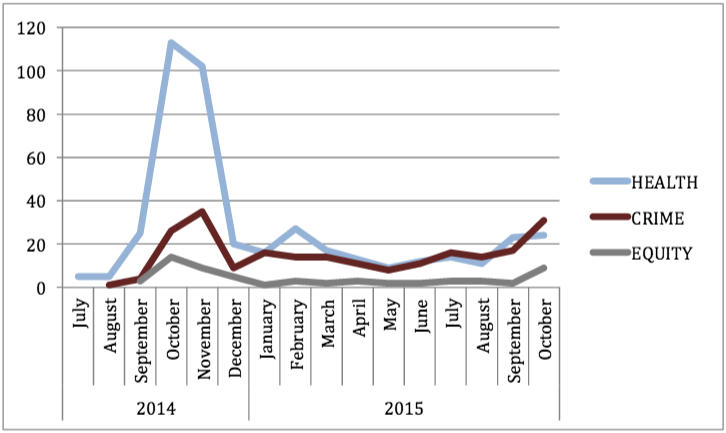Proposition 47: Are health and equity included in news coverage?
by: Leeza Arbatman and Alysha Aziz and Laura Nixon
posted on Wednesday, November 18, 2015
Proposition 47 was an initiative passed by California voters in 2014 that recategorized a number of petty crimes as misdemeanors rather than felonies. The savings from the reduced prison sentences that resulted from this measure are earmarked for mental health and substance abuse treatment, education retention programs, and victim services. This seminal piece of legislation has profound implications for health and equity in the state — but is that reflected in the news?
How Proposition 47 is framed in the news matters because we know that media coverage of an issue shapes the public’s and policymakers’ understanding of it, which, in turn, can influence policy. We wanted to know, does news coverage of Proposition 47 connect the initiative with issues of health or racial equity? Conversely, to what extent does the coverage link the initiative to increases in crime, either real or anticipated?
What we did
We looked at news articles that discussed Proposition 47 from July 2014 (the first time any news articles about the Proposition appeared) through October 2015 (a year after the initiative passed). We noted how often they made mention of health and/or equity, as well as any references to crime increases.
What we found
Coverage of the issue started off with a strong emphasis on health implications. Of all the Proposition 47 articles leading up to the election, over half of them mentioned health (175 articles). For example, in October 2014, a quote from a public health advocate in the Los Angeles Sentinel demonstrated the power of this framing: “While many people associate health with what goes on inside of a doctor’s office, many Prop 47 supporters are seeking to change that. ‘What’s happening in our homes and schools and neighborhoods has a substantial bearing on people’s health status,’ said Tamu Jones, program manager for the California Endowment’s Building Healthy Communities South LA.”
Pre-election, health as a theme appeared five times more often than crime (175 articles and 35 articles, respectively). However, post-election, the health framework tapered off and now risks being overtaken by the discourse on crime. Proposition 47 was often linked with crime increases when local law enforcement announced crime statistics or discussed crime trends and put the blame on Proposition 47. In a typical conflation of Proposition 47 with crime, one opinion piece declared, “In November, voters approved Proposition 47, which downgraded drug possession and many property crimes — including theft of goods worth under $950 — from felonies to misdemeanors. What a gift to shoplifters. And it’s no coincidence San Francisco saw a 47 percent spike in car break-ins in the first half of this year.”

Number of times crime increases, health and equity were mentioned in news and opinion articles about Proposition 47, July 2014 — October 2015
We also found that equity was rarely mentioned in coverage of Proposition 47 either before or after the election, appearing in only 6% of total articles. When it did appear, speakers often pointed to the racial disparities present in California’s criminal justice system. For example, an opinion piece in the Sacramento Bee pointed out, “If Proposition 47 stalls, women of color will be hit hardest. California is the world’s No. 1 jailer of women, who are three times more likely than men to be in prison for low-level, nonviolent offenses. With racial bias playing a significant role in sentencing, the numbers are even higher for black and brown women.”
Implications
Examining the trends in coverage of Proposition 47 is important because the news plays a critical role in shaping public opinion of the measure. This quick examination suggests that health is no longer as prominent in the news conversation as it was prior to the election. This marks a decline in holistic coverage of the initiative. The negligible mention of equity also represents a missed opportunity for journalists to explore the ways in which Proposition 47 can contribute to social justice. In the absence of coverage linking Proposition 47 to these broader issues, stories blaming the initiative for increased crime — largely driven by law enforcement representatives critical of the measure — have the potential to dominate the debate and shift public opinion against this precedent-setting policy.
These findings highlight the need for comprehensive media coverage on the implementation of Proposition 47 that does more than focus on crime statistics. One opportunity to expand the coverage may be the rollout, in 2016, of funding for substance abuse treatment, mental health services and other programs, made possible by the savings from the measure. Highlighting the links between decriminalization and these prevention measures could provide an important opportunity to bring health and equity back into the conversation.



